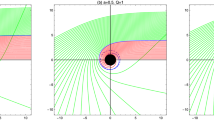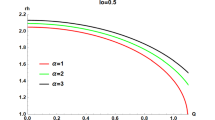Abstract
Here, we study the effect of strong gravitational field on the light rays emitted from the particles in the accretion disk in the vicinity of the Kerr–Newman–NUT–Kiselev (KNNK) black hole in the Rastall gravity (RG). In our analysis we consider the thin accretion disk model of Novikov and Thorne. We observe that the thermal flux of the accretion disk strongly depends on the intensity of the quintessence in the spacetime of the KNNK black hole in the RG, and the flux decreases for the increasing values of the quintessential intensity. We also notice that the smaller values of the equation of state parameter \(\omega _q\), for the quintessence, reduces the thermal flux for very small values of the Rastall parameter \(\kappa \lambda \). Further we use the numerical codes, namely, the GYOTO and TM (Temurbek Mirzaev) codes, using C++ and Python languages, to compare the shadow cast by the KNNK black hole in the RG. We see that both the codes give similar behavior of the shadow cast by the KNNK black hole in the RG. Interestingly, we observe that the left hand side of the apparent black hole environment with respect to the central black hole is much brighter than the right hand side. This is due to the Doppler effect, i.e. the frequency of photons coming towards the observer (and thus the observed flux energy) is always higher than those of moving away form the observer. We demonstrate that increase of the quintessential intensity increases the size of the shadow cast by the KNNK black hole in the RG, considerably when the parameter \(\kappa \lambda \) is very close to zero. We also see that the change in the size of the shadow of the KNNK black hole in the RG becomes negligible with the change in the quintessential intensity parameter \(\alpha \), when the parameter \(\omega _q\) is close to zero and it becomes considerable when the parameter \(\omega _q\) is smaller than zero. Next, we show that the position and shape of the shadow cast by the KNNK black hole in the RG strongly depends on the inclination angle of the incident light. We notice that the shadow of the KNNK black hole in the RG has more circular-like form for smaller values of the inclination angle. Further the shadow of the KNNK black hole in the RG shifts towards the right and becomes more deformed with the increasing values of the inclination angle.













Similar content being viewed by others
Data Availability Statement
This manuscript has no associated data, or the data will not be deposited. (There are no observational data related to this article. The necessary calculations and graphic discussion can be made available on request).
References
H. Falcke, F. Melia, E. Agol, Astrophys. J. 528, L13 (2000). https://doi.org/10.1086/312423
K. Akiyama et al., Astrophys. J. Lett. (2019). https://doi.org/10.3847/2041-8213/ab0f43
W.M. Farr, N. Sravan, A. Cantrell, L. Kreidberg, C.D. Bailyn, I. Mandel, V. Kalogera, Astrophys. J. 741, 103 (2011). https://doi.org/10.1088/0004-637X/741/2/103. arXiv:1011.1459 [astro-ph.GA]
R. Takahashi, J. Korean Phys. Soc. 45, S1808 ( 2004). https://doi.org/10.1086/422403. arXiv:astro-ph/0405099
M.A. Abramowicz, P.C. Fragile, Living Rev. Rel. 16, 1 (2013). https://doi.org/10.12942/lrr-2013-1. arXiv:1104.5499 [astro-ph.HE]
N.I. Shakura, R.A. Sunyaev, Astron. Astrophys. 24, 337 (1973)
D.N. Page, K.S. Thorne, Astrophys. J. 191, 499 (1974). https://doi.org/10.1086/152990
M. Milosavljević, V. Bromm, S.M. Couch, S.P. Oh, Astrophys. J. 698, 766 (2009). https://doi.org/10.1088/0004-637x/698/1/766
M. Jamil, I. Hussain, Int. J. Theor. Phys. 50, 465 (2011). https://doi.org/10.1007/s10773-010-0553-5. arXiv:1101.1583 [astro-ph.CO]
A. Jawad, M.U. Shahzad, Eur. Phys. J. C 76, 123 (2016). https://doi.org/10.1140/epjc/s10052-016-3967-2. arXiv:1602.05952 [gr-qc]
A. Jawad, K. Jusufi, M.U. Shahzad, Phys. Rev. D 104, 084045 (2021). https://doi.org/10.1103/PhysRevD.104.084045
I.D. Novikov, K.S. Thorne, in Les Houches Summer School of Theoretical Physics: Black Holes pp. 343–550 (1973)
C.S.J. Pun, Z. Kovács, T. Harko, Phys. Rev. D 78, 024043 (2008). https://doi.org/10.1103/PhysRevD.78.024043
D. Perez, G.E. Romero, S.E.P. Bergliaffa, Astron. Astrophys. 551, A4 (2013). https://doi.org/10.1051/0004-6361/201220378. arXiv:1212.2640 [astro-ph.CO]
A.J. John, Mon. Not. R. Astron. Soc. 490, 3824 (2019). https://doi.org/10.1093/mnras/stz2889. arXiv:1603.09425 [gr-qc]
A. Ditta, G. Abbas, Chin. J. Phys. 65, 325 (2020). https://doi.org/10.1016/j.cjph.2020.03.007
A.M. Bauer, A. Cárdenas-Avenda, C.F. Gammie, N. Yunes (2022) Astrophys. J. 925, 119. https://doi.org/10.3847/1538-4357/ac3a03. arXiv:2111.02178 [gr-qc]
C. Liu, S. Yang, Q. Wu, T. Zhu, J. Cosmol. Astropart. Phys. 2022, 034 (2022). https://doi.org/10.1088/1475-7516/2022/02/034
Z. Kovacs, K.S. Cheng, T. Harko, Astron. Astrophys. 500, 621 (2009). https://doi.org/10.1051/0004-6361/200811412. arXiv:0903.4746 [astro-ph.HE]
T. Harko, Z. Kovacs, F.S.N. Lobo, Phys. Rev. D 79, 064001 (2009). https://doi.org/10.1103/PhysRevD.79.064001. arXiv:0901.3926 [gr-qc]
K.V. Staykov, D.D. Doneva, S.S. Yazadjiev, JCAP 08, 061 (2016). https://doi.org/10.1088/1475-7516/2016/08/061. arXiv:1606.01529 [gr-qc]
S. Paul, R. Shaikh, P. Banerjee, T. Sarkar, JCAP 03, 055 (2020). https://doi.org/10.1088/1475-7516/2020/03/055. arXiv:1911.05525 [gr-qc]
J.F. Hawley, L.L. Smarr, J.R. Wilson, (1983)
D. Molteni, D. Ryu, S.K. Chakrabarti, Astrophys. J. 470, 460 (1996). https://doi.org/10.1086/177877. arXiv:astro-ph/9605116
P. Amaro-Seoane, M. Freitag, R. Spurzem, Mon. Not. R. Astron. Soc. 352, 655 (2004). https://doi.org/10.1111/j.1365-2966.2004.07956.x. arXiv:astro-ph/0401163
P.C. Fragile, P. Anninos, Astrophys. J. 623, 347 (2005). https://doi.org/10.1086/428433
S. Koide, D.L. Meier, K. Shibata, T. Kudoh, Astrophys. J. 536, 668 (2000). https://doi.org/10.1086/308986. arXiv:astro-ph/9907435
F.H. Vincent, T. Paumard, E. Gourgoulhon, G. Perrin, Class. Quant. Grav. 28, 225011 (2011). https://doi.org/10.1088/0264-9381/28/22/225011. arXiv:1109.4769 [gr-qc]
D. Psaltis, T. Johannsen, Astrophys. J. 745, 1 (2012). https://doi.org/10.1088/0004-637X/745/1/1. arXiv:1011.4078 [astro-ph.HE]
D. Ayzenberg, N. Yunes, Classical Quantum Gravity 35, 235002 (2018). https://doi.org/10.1088/1361-6382/aae87b. arXiv:1807.08422 [gr-qc]
A.B. Abdikamalov, A.A. Abdujabbarov, D. Ayzenberg, D. Malafarina, C. Bambi, B. Ahmedov, Phys. Rev. D 100, 024014 (2019). https://doi.org/10.1103/PhysRevD.100.024014. arXiv:1904.06207 [gr-qc]
B.S. Haridasu, V.V. Luković, R. D’Agostino, N. Vittorio, Astron. Astrophys. 600, L1 (2017). https://doi.org/10.1051/0004-6361/201730469. arXiv:1702.08244 [astro-ph.CO]
V.V. Kiselev, Class. Quant. Grav. 20, 1187 (2003). https://doi.org/10.1088/0264-9381/20/6/310. arXiv:gr-qc/0210040
B. Toshmatov, Z. Stuchlík, B. Ahmedov, Mod. Phys. Lett. A 32, 1775001 (2017). https://doi.org/10.1142/S0217732317750013. arXiv:1707.00403 [gr-qc]
M.F.A.R. Sakti, A. Suroso, F.P. Zen, Eur. Phys. J. Plus 134, 580 (2019). https://doi.org/10.1140/epjp/i2019-12937-x. arXiv:1909.06595 [hep-th]
N.U. Mollaand, U. Debnath, Int. J. Modern Phys. A 36, 2150210–168 (2021). https://doi.org/10.1142/S0217751X21502109
M.F.A.R. Sakti, A. Suroso, F.P. Zen, Ann. Phys. 413, 168062 (2020). https://doi.org/10.1016/j.aop.2019.168062. arXiv:1901.09163 [gr-qc]
P. Rastall, Phys. Rev. D 6, 3357 (1972). https://doi.org/10.1103/PhysRevD.6.3357
M. Visser, Phys. Lett. B 782, 83 (2018). https://doi.org/10.1016/j.physletb.2018.05.028. arXiv:1711.11500 [gr-qc]
F. Darabi, H. Moradpour, I. Licata, Y. Heydarzade, C. Corda, Eur. Phys. J. C 78, 25 (2018). https://doi.org/10.1140/epjc/s10052-017-5502-5. arXiv:1712.09307 [gr-qc]
Y. Heydarzade, H. Moradpour, F. Darabi, Can. J. Phys. 95, 1253 (2017). https://doi.org/10.1139/cjp-2017-0254. arXiv:1610.03881 [gr-qc]
R. Kumarand, S.G. Ghosh, Eur. Phys. J. C 78, 750 (2018). https://doi.org/10.1140/epjc/s10052-018-6206-1
B. Narzilloev, I. Hussain, A. Abdujabbarov, B. Ahmedov, C. Bambi, Eur. Phys. J. Plus 136, 1032 (2021). https://doi.org/10.1140/epjp/s13360-021-02039-x. arXiv:2110.01772 [gr-qc]
B. Narzilloev, D. Malafarina, A. Abdujabbarov, C. Bambi, Eur. Phys. J. C 80, 784 (2020). https://doi.org/10.1140/epjc/s10052-020-8370-3arXiv:2003.11828 [gr-qc]
B. Narzilloev, J. Rayimbaev, A. Abdujabbarov, C. Bambi, Eur. Phys. J. C 80, 1074 (2020). https://doi.org/10.1140/epjc/s10052-020-08623-2. arXiv:2005.04752 [gr-qc]
S. Shaymatov, B. Narzilloev, A. Abdujabbarov, C. Bambi, Phys. Rev. D 103, 124066 (2021). https://doi.org/10.1103/PhysRevD.103.124066
B. Narzilloev, D. Malafarina, A. Abdujabbarov, B. Ahmedov, C. Bambi, Phys. Rev. D 104, 064016 (2021). https://doi.org/10.1103/PhysRevD.104.064016
J. Rayimbaev, B. Narzilloev, A. Abdujabbarov, B. Ahmedov, Galaxies (2021). https://doi.org/10.3390/galaxies9040071
B. Narzilloev, J. Rayimbaev, A. Abdujabbarov, B. Ahmedov, Galaxies (2021). https://doi.org/10.3390/galaxies9030063
B. Narzilloev, S. Shaymatov, I. Hussain, A. Abdujabbarov, B. Ahmedov, C. Bambi, Eur. Phys. J. C 81, 849 (2021). https://doi.org/10.1140/epjc/s10052-021-09617-4. arXiv:2109.02816 [gr-qc]
Z. Xu, Y. Liao, J. Wang, Int. J. Mod. Phys. A 34, 1950185 (2019). https://doi.org/10.1142/S0217751X19501859
I. Banerjee, S. Chakraborty, S. SenGupta, Phys. Rev. D 100, 044045 (2019). https://doi.org/10.1103/PhysRevD.100.044045. arXiv:1905.08043 [gr-qc]
S.X. Tianand, Z.H. Zhu, Phys. Rev. D 100, 064011 (2019). https://doi.org/10.1103/PhysRevD.100.064011
C. Bambi, Black Holes: A Laboratory for Testing Strong Gravity (Springer, Singapore, 2017)
K. Akiyama et al., Astrophys. J. 875, L1 (2019). https://doi.org/10.3847/2041-8213/ab0ec7. arXiv:1906.11238 [astro-ph.GA]
K. Akiyama et al., Astrophys. J. Lett. 875, L2 (2019). https://doi.org/10.3847/2041-8213/ab0c96. arXiv:1906.11239 [astro-ph.IM]
Acknowledgements
This research is supported by Grants F-FA-2021-432, F-FA-2021-510 and MRB-2021-527 of the Uzbekistan Ministry for Innovative Development. A.A. and B.A. acknowledge the support of Uzbekistan Ministry for Innovative Development Grants and the Abdus Salam International Centre for Theoretical Physics under the Grant No. OEA-NT-01.
Author information
Authors and Affiliations
Corresponding author
Rights and permissions
Springer Nature or its licensor (e.g. a society or other partner) holds exclusive rights to this article under a publishing agreement with the author(s) or other rightsholder(s); author self-archiving of the accepted manuscript version of this article is solely governed by the terms of such publishing agreement and applicable law.
About this article
Cite this article
Mirzaev, T., Li, S., Narzilloev, B. et al. Simulated image of the shadow of the Kerr–Newman–NUT–Kiselev black hole in the Rastall gravity with a thin accretion disk. Eur. Phys. J. Plus 138, 47 (2023). https://doi.org/10.1140/epjp/s13360-022-03632-4
Received:
Accepted:
Published:
DOI: https://doi.org/10.1140/epjp/s13360-022-03632-4




